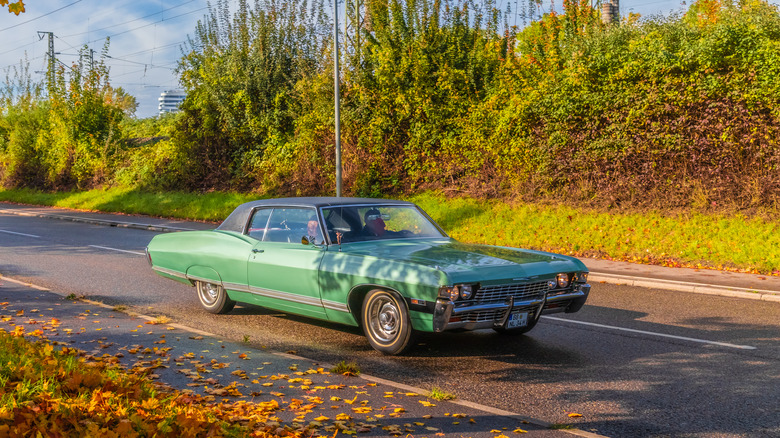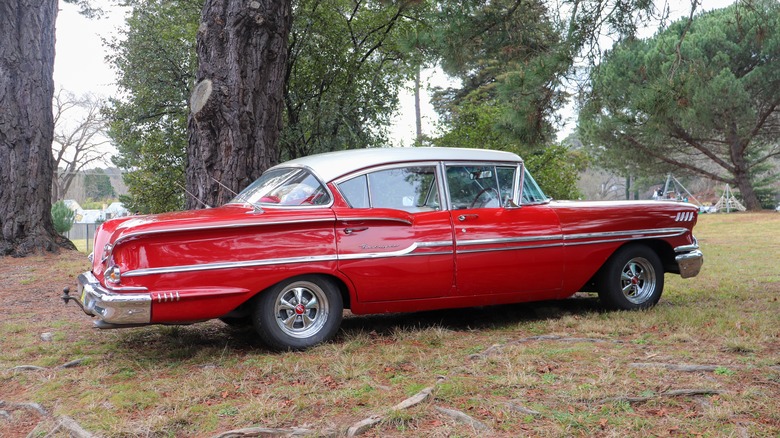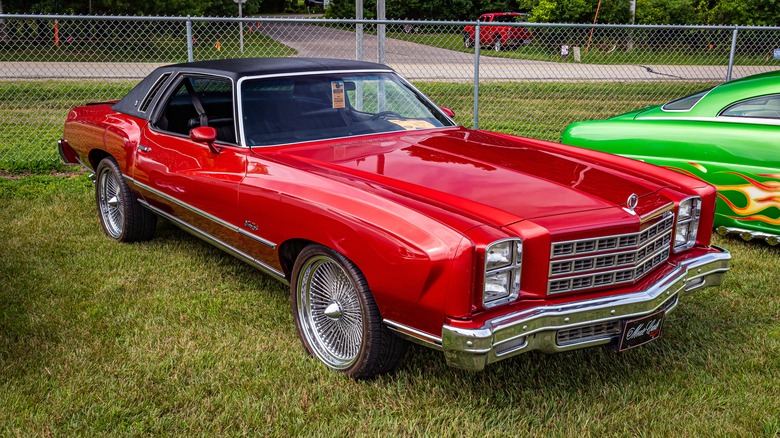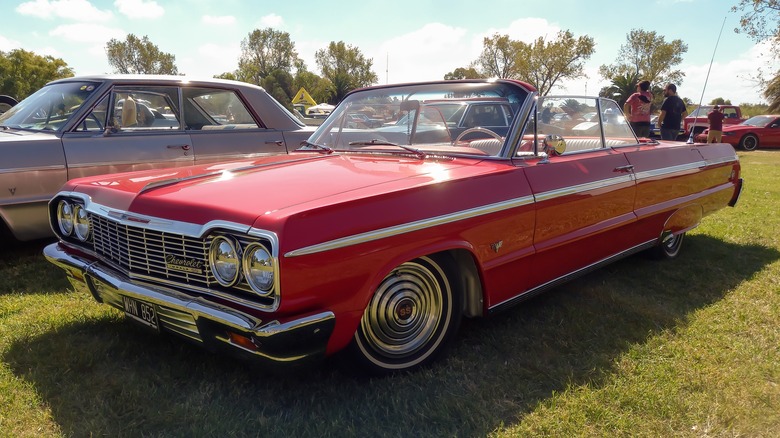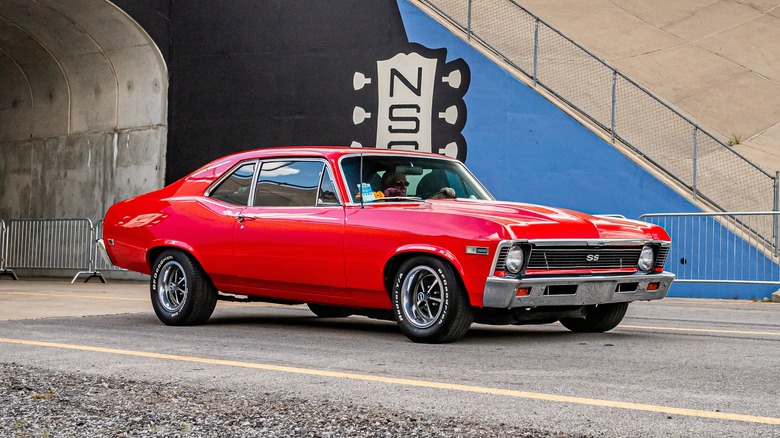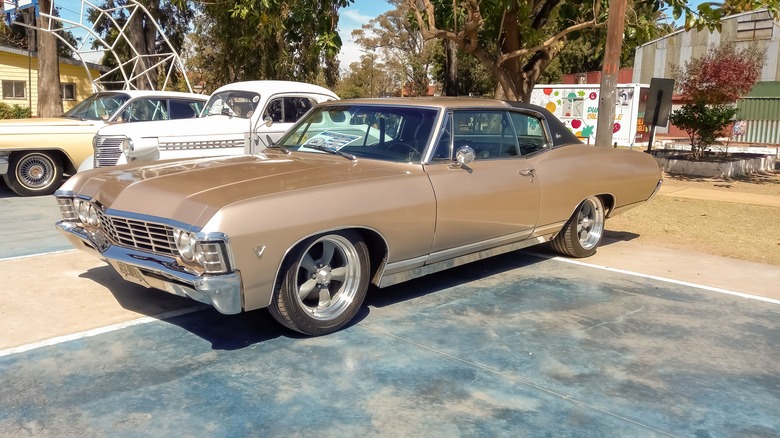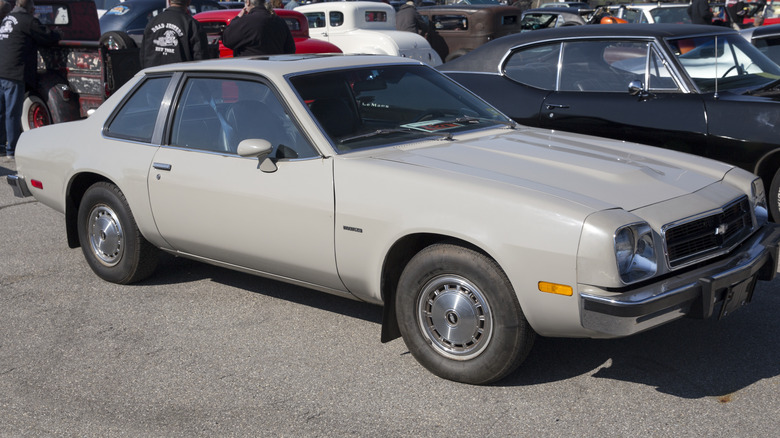6 Of The Most Underappreciated Chevrolet Muscle Cars
Chevrolet is one of the most enduring brands in the automotive industry. Louis Chevrolet and William Durant founded the company in 1911 and debuted their first vehicle, the Series C Classic Six, two years later at the New York Auto Show. In 1918, Durant engineered a reverse merger with General Motors; a reverse merger is when a private company acquires a public company to shortcut the IPO process. The brand grew quickly in the following years, and by 1929, Chevrolet had overtaken Ford as the nation's best-selling automaker.
Chevrolet's century-plus history includes the production of legendary muscle car models like the Corvette, Camaro, and the Chevelle. While all of those cars have earned their rightful place in muscle car history with their performance and styling, Chevy also designed and built many other powerful and sleek cars in the '60s and '70s that are not quite as beloved or coveted by enthusiasts or collectors.
This means they can often be found at relatively bargain prices or simply languishing forgotten under a tarp in someone's barn or garage. Here is a chance to learn more about some of Chevy's lesser-regarded muscle car models.
Biscayne
Chevy introduced the Biscayne in 1958 and gave it a redesign in 1961 and 1965. A fourth generation was produced between 1971 and 1975 but was only sold in Canada. The Biscayne was a relatively bare-bones model, and after the Delray was dropped in 1959, it became Chevy's least expensive full-sized car until the end of its production run. The 1959 Biscayne sold for just $2,301, and the model's enduring low cost (the 1971 model carried a sticker price of $3,448) made it a popular choice for taxi companies and police squads.
The first generation Biscayne was available with engines ranging in size from a 235 cubic inch I6 to a 348 cubic inch V8 that produced 315 horsepower and 356 pound-feet of torque. The 348-equipped Biscayne could go from zero to 60 in 5.8 seconds and reach a top speed of 121 mph, impressive benchmarks for a car that weighed more than 3,800 pounds. By 1968, a 427 cubic inch V8 producing 385 horsepower and a staggering 460 pound-feet of torque was available. This beast weighed almost two tons, however, and delivered a combined fuel economy of less than 10 mpg.
The Biscayne's no-frills design and the fact that so many of them were driven hard by taxi drivers and law enforcement officers has made for a wildly inconsistent market today. Good condition examples from the first two generations have sold in the past two years for between $9,300 and $96,000, and a 1958 two-door model in need of some work was listed on Craigslist in Kansas earlier this fall for just $6,000.
Monte Carlo
The Monte Carlo is another full-sized Chevy that has endured over many years and several generational updates. It was introduced in late 1969 as a 1970 model and remained in production until 2007, except for a hiatus from 1989 through 1994. It originally shared some body parts with the Chevelle, although it had a longer wheelbase.
The first generation Monte Carlo shared a platform with the Pontiac Grand Prix and came with one of three V8 engines ranging in size from 350 to 454 cubic inches. A 454-powered 1972 Monte Carlo weighed more than 3,800 pounds but could still go from zero to 60 in 6.8 seconds.
The introduction of the second generation in 1973 brought a Motor Trend Car of the Year award win, and Chevy produced nearly a quarter of a million Monte Carlos that year. GM's output climbed throughout the generation, peaking at just over 400,000 units in 1977. Chevrolet began to slim down and square off the model the following year, and a turbocharged 231 cubic inch V6 engine became an option in 1980.
Monte Carlo's sales declined steadily throughout the 1980s to a low of about 30,000 units in 1988. It was dropped the following year but revived in 1994 in two V6-powered trim versions, the LS and the Z34. Throughout its lifespan, the Monte Carlo was a huge success on the NASCAR track, winning championships for Richard Petty, Dale Earnhardt, and Jimmie Johnson.
The high production numbers during even the most desirable model years make Monte Carlos a relative bargain on the secondhand market; two second-generation models sold this fall for less than $8,500.
Impala
Another one of Chevrolet's models that often eludes the attention of muscle car collectors is the Impala. The Impala first appeared at GM's 1956 Motorama show as a concept car Motor Trend called "effectively a five-seat hard-top Corvette" and made its way to dealer lots two years later as a premium trim package on the Bel Air. It became a standalone model in 1959, with engines ranging in size from a 235 cubic inch I6 to a 348 cubic inch V8 that produced 315 horsepower.
In 1961, Chevy introduced the Impala SS, which could be had with a 409 cubic inch V8 capable of 360 horsepower. In the summer of 1963, a gold Impala manufactured at Chevy's plant in Tarrytown, New York, was the brand's 50 millionth vehicle produced. The Impala was restyled for the 1965 model year, and Chevy set a record that year by selling more than a million Impalas.
The model was one of many that was reduced in size in the late '70s, and the nameplate was dropped in 1986 in favor of the nearly identical Caprice. Chevrolet couldn't give up on the Impala, however, reintroducing it in 1994, 2000, and 2014 before abandoning the model again in 2020.
Like with the Monte Carlo, the Impala's high production numbers during its heyday make the model a relative bargain today; '60s-era coupes and sedans routinely change hands for less than $20,000, although a 1958 convertible sold last year for $163,000.
Nova
Chevy first used the Nova badge on the top trim level of the Chevy II compact in 1962. It came in five body styles: two and four-door sedans, a four-door wagon, and two-door coupe or convertible versions. The coupe and convertible bodies could be purchased with the Super Sport package beginning in 1963, but soon, the larger and more powerful Chevelle put a sizable dent in Nova's sales.
In 1966, Chevy began offering a 327 cubic inch V8 that produced 350 horsepower in the Nova, but again, internal competition dinged the model's sales (this time, the culprit was the newly introduced Camaro).
An urban legend claims that the Nova didn't sell well in Spanish-speaking countries because the name translates to "doesn't go" in Spanish. But Snopes points out that this is incorrect, and the Nova actually performed well in Mexican and South American markets. "Although 'no va' can be literally translated as 'no go,' a Spanish speaker would refer to a malfunctioning automobile by saying 'no marcha' or 'no funciona' or 'no camina' rather than 'no va.'"
A redesign came in 1968, along with engine upgrades, including a 425 horsepower, 427 cubic inch V8. The 1970 Clean Air Act forced many manufacturers to scale down muscle car production, and the SS option was dropped in 1976. The Nova's fifth generation run ended in 1979, but Chevy brought the nameplate back in 1984 as part of its NUMMI partnership with Toyota; the 1980s-era Nova was essentially a rebadged Corolla and would go on to become the Geo Prizm.
Caprice
The Caprice began as the Z18 option package on the mid-year 1965 Impala. For $242.10 extra, Impala Caprice buyers got higher quality seat material, real walnut trim on the door panels and dash, and added touches like deep-pile carpet and a nicer headliner. The Caprice nameplate was issued on its own in coupe, sedan, and station wagon forms in 1966 and got full generational updates in 1971, 1977, 1991, 1999, and 2006.
Early Caprice buyers could opt for a selection of V8 engines from 283 cubic inches all the way up to the 427 cubic inch beast that produced 425 horsepower. Just as it did with the Monte Carlo and the Impala, Chevy downsized the Caprice in the 1970s in response to the oil crisis and changing consumer tastes.
The Caprice kept its refined edge and robust performance, and Chevy added "Classic" to the model's moniker in 1973. Motor Trend named the Caprice Classic Car of the Year in 1977, singling out Chevrolet for its ability to "combine engineering, passenger comfort, handling, performance, and styling into the best single package."
Like the Biscayne and Impala, the Caprice has long been a favorite of law enforcement and taxi companies, making gently treated classics a rarity. It's common to find them for sale for well under $10,000, even the more desirable '70s and '80s models.
Monza
Not every Chevy muscle car was a two-ton behemoth with a big block V8 and a multi-decade production run. The Monza was in production as a subcompact from 1975 through 1980, although Chevy also used the name on a submodel of the Corvair from 1960 through 1964. The 1970s Monza shared GM's H-body platform with the much-maligned Vega, and initially, Chevy wanted to outfit the Monza with the GM version of the Wankel rotary engine. Issues with emissions and poor fuel economy scrapped those plans, however, and the first Monzas came with either the Vega's 140 cubic inch four-cylinder or a 262 or 350 cubic inch V8.
The automotive press of the day loved the Monza. Car and Driver called its design "stunning," and Motor Trend awarded the V8 version the 1975 Car of the Year award (via Hagerty). Chevy sold over 700,000 Monzas during its short run, but even the 350-equipped Monzas were underpowered. That engine generated just 125 horsepower and took 11 seconds to drag the car from zero to 60 mph. Despite Monza's sluggish performance off the lot, it became a racetrack juggernaut. Monzas, modified by DeKon Engineering, won the IMSA GT championship in 1976, 1977, and 1978.
The somewhat lackluster performance and subpar build quality sent many Monzas to the scrapyard. But the Monza's unique styling and upgrade readiness make a rust-free example worth saving, especially considering they don't come on the open market very often. Bryan McReady, the site operator at monzahomestead.com, hosts an annual cookout and H-body modders convention in Ontario, Canada. He told Hagerty, "There's a lot of interest in these cars, and cars that were hidden away are coming out."
[Featured image by Mr.choppers via Wikimedia Commons | Cropped and Scaled | CC-BY 3.0]
